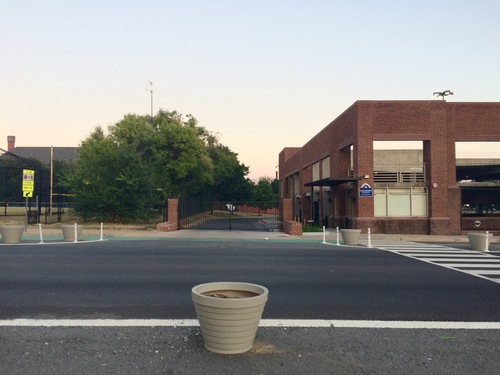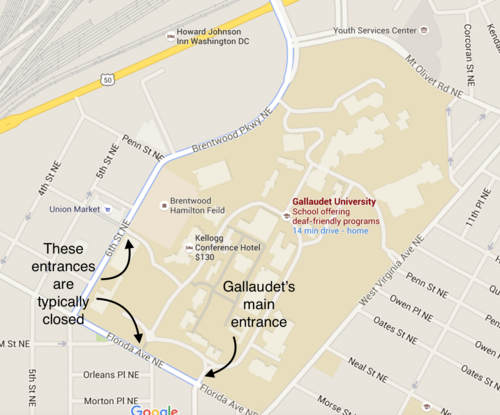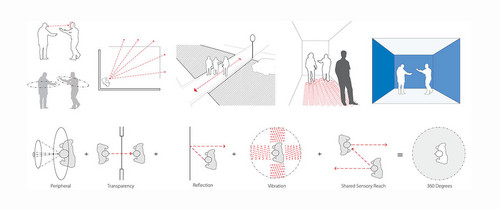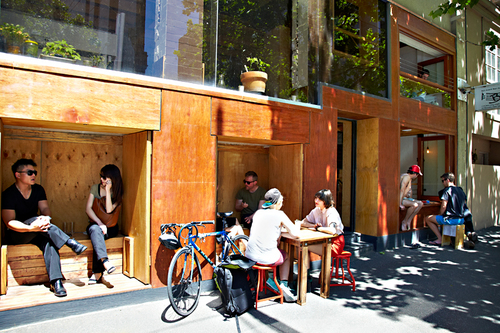When it redesigns its campus, Gallaudet hopes to pioneer architecture for the Deaf
The southwestern edge of Gallaudet University borders a growing urban center, but fences close the campus off. Now, the school is rethinking its design and redevelop some of its land to bolster finances. To do this, it’s reimagining 6th Street NE as a corridor that zips together deaf and hearing communities.
Gallaudet is using two projects to create the first urban environment designed for the deaf. First, it’s redesigning its public spaces, including the 6th Street streetscape, the campus grounds, and a few small buildings. Second, it’s developing four large parcels of land that front 6th Street NE.
As the world’s only university for the Deaf and Hard of Hearing, Gallaudet has a set of design guidelines the school calls DeafSpace; the redesigns will fit with both that and the 10-year master plan that zoning requires.
Gallaudet wants new buildings and new ideas for tailoring its design to the Deaf
Gallaudet’s main entrance on Florida Avenue NE is nearly half a mile from where Union Market, the neighborhood’s new attraction, sits on 6th Street. Redeveloping the parking garages and auxiliary buildings there will tie the campus to its surroundings without harming its historic campus by Frederick Law Olmsted, Sr., who also designed Central Park.
A large part of the development plan has already started. In 2014, the school selected the developer JBG and architect Morris Adjmi; the team behind the Atlantic Plumbing project at 8th & V NW, to build 1.3 million square feet of building on the parcels.
Gallaudet has already used internal workshops and two design processes to pioneer a way of designing spaces for the Deaf. The school wants to stay innovative in this field as moves forward, so it’s holding a two-part design competition to shape its public spaces. For now, it’s gathering input from neighboring communities and asking for designers to form teams with specializations like interaction design in addition to architecture and urban planning.
A panel will narrow those teams down to just a handful in October, and the teams will then submit rough designs for feedback from the student and neighborhood communities. After a round of revisions, a jury of experts will pick a winning approach in February.
Using a competition allows Gallaudet to draw on a range of expertise that goes beyond the immediate community, which is important given that this is the school’s largest planning endeavor to date.

The Gallaudet master plan emphasizes connections towards the NoMa-Gallaudet Metro. Image from Gallaudet.
Creating spaces for deaf people presents unique challenges
Gallaudet is promising vibrant streets and high standards of sustainability, both of which are now common in DC projects. But making spaces for deaf people will require designers to think a little harder than usual.
Gallaudet developed its DeafSpace guidelines when it realized its campus didn’t suit how the Deaf use buildings and streets. The guidelines go way beyond the “universal design” requirements of the Americans with Disabilities Act. Instead of focusing just on patches for audiological deafness, uncapitalized, DeafSpace is custom tailored to culture shared by people participating in Deaf (capitalized) communities.
It’s not an overstatement to say there’s a distinct Deaf Culture. Many of our social norms, from how we say goodbye to what kind of art we enjoy, rely on hearing. The Deaf have different norms, and the way they talk is also different from English speakers. Although most deaf students can read and write English, American Sign Language is an entirely distinct language, with different grammar, vocabulary, and dialects.
In sign language, a single hand sign changes meaning depending on where the signer makes it, its orientation, movement, and what their facial expression is. To communicate in ASL, you need to see the whole upper body. A bar with low, intimate lighting will kill an ASL conversation the same way loud background music does for the hearing.
Since Deaf Culture prefers clear vision and generous personal space, those are the conceptual building blocks. Sign language requires people to stand further apart and use more space, so, hallways have to be wider. Signers have to keep their hands free, so in DeafSpace, there are as few manually opening doors as possible.
If a deaf person can’t see through a door, they can’t tell if someone’s in a room, so windows are helpful. But at the same time, an ASL user can spy on a conversation through that glass. In this case, translucency balances the competing needs. In general, reflective surfaces on cabinets or walls a deaf person might often face help with spatial awareness. Even paint helps: blue walls help hands and faces pop no matter the skin tone.
DeafSpace is a distillation of these needs and solutions into what the architectural theorist Christopher Alexander calls “patterns:” generic rules and forms that a designer can combine to create a multifunctional, comfortable space. The leader of the DeafSpace project, Hansel Bauman, sees it as a way of designing spaces around Deaf interactions and experiences.
But DeafSpace has few patterns that apply to open areas and urban space. Do crosswalks have to heighten visibility? If sidewalks have to be wider, do they cut into sidewalk cafes and increase the area of surfaces impermeable to rainwater? There are a lot of new issues open spaces present. I think bringing more brainpower to these issues is why Gallaudet is holding the design competition.
Plus, Bauman wants to take the concept further, to design spaces more tightly around human behaviors and sensations, irrespective of specific abilities. That might seem basic, but between a tendency to stick to financially proven conventions or get lost in an artistic vision, it’s easy to forget the human interaction behind the built environment. The competition could bring this idea some much needed attention.
Tailoring an urban space for Deaf experience may force competing teams to get back to basics about how spaces facilitate interaction between people. Maybe the competition will let designers to reexamine the patterns of design for a sidewalk cafe or a multi-story building’s front door.
Gallaudet’s decision to open up its campus to a pedestrian-friendly, dense 6th Street is an extremely promising step. One step further would be taking the focus on buildings as amplifiers of social interaction and applying that design across the city.





